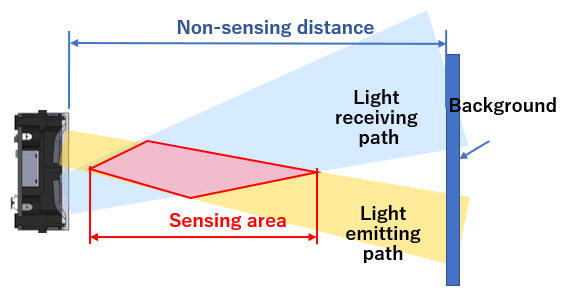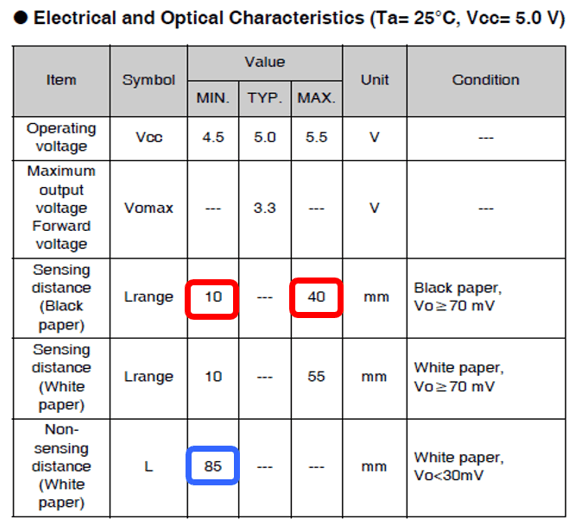Explain how to read the electrical and optical characteristics table of the analog output model of Optical Sensor:B5W-LB.
ID: FAQE40037E
update:
Answer
This is a light convergent reflective type Optical Sensor and the sensing area is limited. Therefore, the range of the sensing area of the sensor is indicated as the sensing distance, and the area where the background object is not detected is indicated as the non-sensing distance. In addition, because this sensor is used in applications to detect various objects, the sensing distance is defined by white paper with high reflectivity and black paper with low reflectivity.
Explanation

The optical characteristics of the sensor can be checked mainly by “Receiver output – sensing distance characteristics.” This characteristic diagram is a graph that measures the relationship between the sensor output voltage and sensing distance for various sensing objects. For example, regarding the sensing distance for black paper, the range of the sensing distance (black paper) in the “Receiver output – sensing distance characteristics” shown below means that the output voltage is 70 mV or higher in the distance range of 10 to 40 mm.
In addition, the non-sensing distance is specified based on a white paper, and the non-sensing distance (white paper) in the diagram means that the output voltage is 30 mV or less in the distance range of 85 mm or more.
When designing the structure of the equipment, the distance between the sensor and the sensing object should be determined by referring to the “Receiver output – sensing distance characteristics.”
In cases where the sensing object position does not fluctuate, the sensing distance is recommended to be set at the peak of the graph’s curve.


Quick tips
Commercially available white and black papers are used to specify the characteristics’ values.
In actual applications, however, objects of different colors, sizes, and shapes are detected. Therefore, when designing equipment, it is essential to set the optimum sensing distance of the sensing object and evaluate whether the sensor can achieve long-term stable sensing in your applications. Specifically, it is necessary to measure “Sensing distance – output voltage” using actual objects. Assuming the lowest value of the output voltage in the range of the sensing distance on the actual equipment, as well as the worst value in consideration of angular dispersion of the sensing object, deterioration of the surface condition, scratches, and dust, the threshold value is set while taking the margin into account. Although the lower limit of the recommended threshold is 40 mV or higher, set the value according to the noise environment of the actual equipment.
| Product category | Sensors Light Convergent Reflective Sensors/Diffuse Reflective Sensors |
|---|---|
| Classification | Selection, Characteristics |
| Related keywords |
|